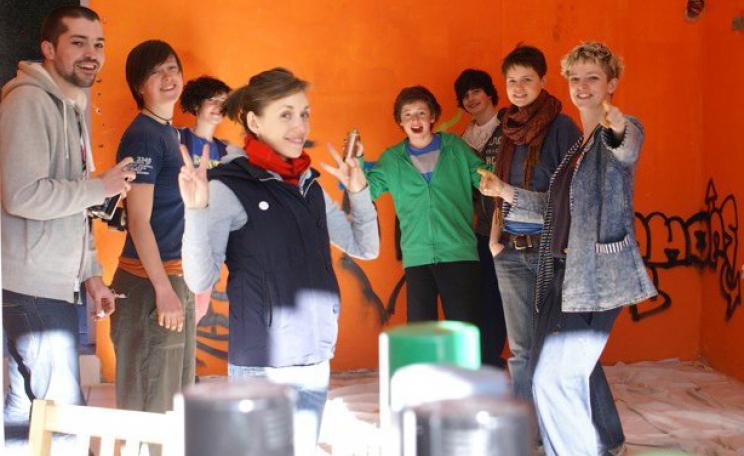
Bush’s latest’ state of the union speech – wanting 20 per cent bio-fuels from food crops to be driving the US fleet in 10 years –makes two things remarkably clear. First even the Toxic Texan now sees the environment as a vote winner. And second, people such as him are still looking for the answers in the wrong place.
To see where the answers might lie he needs to look beyond the cornfields of the Midwest. To somewhere aiming to be nuclear free by 2010 and oil-free by 2020. To Sweden. This radical energy policy, the most ambitious of its kind in the world, was introduced by the socialists and adopted, after a recent change of government, by the equivalent of the Tories. In terms of ecological consciousness and seeking bipartisan solutions to environmental problems it affirms that Sweden is a good 20 years ahead of either Britain or America.
The country’s environmental awakening started in the Eighties when two separate but connected events shocked the country. First there was the bleached coffee filter paper scandal. People liked the filter paper for their coffee machines to be white. But then it was discovered that the chemicals used in the manufacturing process left cancer-causing residues and were causing environmental degradation simply so we could have something that looked aesthetically pleasing. Then dead seals started to appear off the north-west coast. The Swedes put two and two together and realized that the fundamental processes used in manufacturing were having a direct impact on the environment. And determined that they were going to do something about it.
So they set their minds to addressing these issues, as fishing, forestry and agriculture are critical parts of their economic portfolio. How best to use their natural resources is tantamount. Biofuels there have been used as a fuel extender for petrol-engined vehicles for years. Today, almost 40,000 cars in the country are powered by some form of alternative fuel. Last year sales were up 168 per cent. By the end of 2006 sales of alternative fuel cars were expected to account for about 20 per cent of all new cars sold.
However, the biofuels approach currently being endorsed by Bush and others is already recognised by the Swedes as being an ultimately unsustainable solution and of little help even in meeting the modest targets for cutting C0² emissions set by the EU. So while the rest of the world is only now belatedly jumping on the bio-fuels bandwagon, the Swedes have already moved on to the next phase.
Today, they are concentrating on non-food-crop biomass for energy production and fuel, in the form of biogas, for cars, both of which have far greater potential to play a long and lasting role in providing green fuel and green energy. Rather than sow new plants that compete for space with food crops, they are using the waste products of their society – anything from woodchip to slaughterhouse slurry – and turning them into fuel.
In December last year they opened the world’s largest biogas plant. Costing 3.2 million Euro, the Gothenburg plant will be able to produce 1,600 cubic metres (cu/m) (56,000 cubic feet) of biogas per hour. This will be done by refining gas from the city’s wastewater treatment plant into biogas.
Outside of Gothenburg, the government and 25 local municipalities have backed an initiative to build 200 new biogas stations over the next two to three years. Expansion on this scale and at this speed will replace the need for around 35 million litres of petrol and diesel fuel, cutting emissions by 50,000 tonnes a year; a clear signal to business and the public to have confidence and invest in the sector.

The country already has 779 biogas driven buses. In the city of Linköping for example, all the buses and many of the taxis run on biogas produced locally from slaughter waste, agricultural waste and other kinds of food/organic waste. Across the country, sales of biogas-powered cars increased by 49 percent in 2005.
Not that they’ve stopped there. Last year Sweden unveiled the world’s first biogas powered train. Driven by two biogas bus engines it can carry up to 54 passengers at 81 miles an hour and run for 372 miles before it need refuel. It cost them just 1.08 million Euros to develop.
Closing the loop
Biogas is produced in essentially two different ways – by biodigesters and bioreactors. From the cities of Sweden to remote rural villages of China anaerobic biodigesters are becoming increasingly commonplace to see. These are essentially micro-generators where animal manure and organic matter (food waste, agriculture wastes and so forth) are fed into a chamber. They combine with the oxygen in the air and heat up naturally, just as in a compost heap. As they do so they produce two things; gas (predominantly methane with a small percentage of carbon monoxide), and a slurry of sterile (non-toxic) nitrogen compounds.
The gas is then piped to a generator, which uses it as fuel to supply power to the village or farm for household appliances and electricity driven farm machinery. Anaerobic digestion also removes the need for petrochemically produced fertliser, which in the UK accounts for around 14 per cent of GHG emissions – the same as industry. The result: with the exception of the release of a tiny amount of methane gas, a totally green whole cycle power system.
Aside from the climate benefits, replacing costly chemical fertilisers with cheap, produced on site ones from an anaerobic digesters can also boost farm incomes. In Germany this potential is already being harnessed. There, farms with herds of around 500 head of cattle are paid to ‘biodigest’ their wastes, the gas from which is then bought and collected. For struggling farmers in the UK, biodigesters could make a dramatic impact on their balance sheets. For example, an average hill farm in Wales running 500 sheep on 100 acres – the minimal possible to make it anyway approaching economical – would spend around 30 per cent of its annual income on petrochemically produced fertiliser.
Bioreactors run on a slightly different principle to biodigesters, and use both heat and pressure to speed up waste conversion, like giant kitchen pressure cookers. And they do it on a grander scale and faster. Where a biodigester would run over a 10 day cycle, a bioreactor completes the same conversion of matter to energy in a few hours, recycling some of the energy it creates to power its own operation. Construction of a bioreactor has recently started in Lockerbie. When in operation the plant will generate enough electricity to power 70,000 homes, offsetting 140,000 tonnes of greenhouse gas emissions each year. The Lockerbie bioreactor will be fuelled by biomass, sourced from the waste matter from the nearby wood processing and pulping industries; a resource that would otherwise by fly-tipped, burnt or landfilled. It’s a solution suitable to Scotland (and potentially Wales) because of its extensive commercial forests.
Closer to home
Bioreacators’ potential doesn’t stop there. The reactors can process practically anything – all human and animal effluent, animal carcasses, garden waste – and convert it into energy. So, for instance, the effluent in rivers such as the Thames could in principle be filtered out to create power, whilst cleaning up the river in the process.
The Institute of Science in Society (ISIS) has calculated that there are somewhere in the region of 88 million tons of effluent and organic waste suitable for anaerobic digestion in the UK. If converted into fuel this could provide 11.7 per cent of our total energy needs and save at least 15.8 per cent of our carbon emissions. Or, create enough liquid fuel to power half our transport needs, saving around 50 per cent of our current transport emissions, which themselves account for 14 per cent of the UK’s total emissions.
Admittedly waste biomass is not quite as clean as carbon neutral forest biomass. Nonetheless it is far cleaner than simply incinerating our waste. For every ton of waste currently incinerated, 2.8 tons of C0² are emitted. When converted to energy in a bioreactor, the process is 10 times cleaner, as the reactors use far less energy than a waste incinerator, and can be fitted with carbon dioxide scrubbers on their exhausts.
Furthermore, they are 85 per cent efficient at recovering energy from waste: an incinerator is only about 10-15 per cent efficient, or less. In sum: you can get five to eight times as much energy, all of it green, from bioreactors than incinerators, at a fraction of the carbon dioxide output. The same applies to anaerobic digesters, which are also very energy efficient.
Another immediate benefit of pursuing the biomass/biogas line is that in the UK we already have the infrastructure in place. Gas travels through pipes, and the pipes already exist to deliver natural gas. Localising production also answers a key question of energy security and addresses the problem of energy wasteage, with 7-25 per cent of the electricity produced in the UK currently being lost simply while being transported around the national grid.
It might also lead to proper funding of recycling services as millions of tons of waste and rubbish can be converted into hundreds of millions of pounds worth of valuable energy, to be sold back to the consumer.
Despite lack of support from central government, across the UK, there are several signs at a local level of people taking the initiative for themselves. In Nottingham for example, Trevor Hardcastle of Hardstaff haulage has developed a simple and effective way to convert a diesel engine to drive on biogas. In an industry that praises operators who have a single-digit profit margin he has reduced his fuel bills by £1m annually. Biogas (and natural/ propane gas) comes in at half the price of diesel (currently around 46p), and is even cleaner. He has even created his own infrastructure so his trucks can refuel along the motorway routes they travel.

A biogas reactor in Denmark. Power plants
such as these are beginning to appear all
over the world
This approach has huge potential. In the UK we currently give bus companies fuel-tax subsidies to the tune of £2bn a year. Yet because these companies operate around fixed points they could – probably more than any other sector – start to convert to biogas immediately. They are already doing this in Mauritius. The only public transport on the island is its bus service, which transports around 200,000 people each day. Earlier last year the country embarked on a scheme to convert its entire fleet of 525 buses to run off biogas, thus tackling its waste, emissions and energy problems in one go.
Wales’s first biomass district heating scheme was launched on 30th June 2006. A 500kW wood chip boiler, installed by Dulas Wood Energy, provides heat to Ysgol Vyrnwy School, Community Centre and 30 houses. Wood chip is sourced from within a 20 mile radius of the school and the scheme is operated through a partnership between Powys County Council, Dulas, Severn Trent Water and the residents.
At the National Botanical Garden of Wales, the Great Glasshouse, the offices, shops and catering facilities currently burn factory waste chippings and shavings that would probably end up in a landfill site otherwise. By about 2010 they hope to use coppiced willow and poplar, grown on an adjacent field.
Kingsmead Primary School in Cheshire has a biomass boiler, producing 60 per cent of the school’s heating needs. Initially fuelled on wood pellets from a local factory, the boiler now runs on waste factory wood chips sourced in Manchester. In combination with photovoltaic panels and solar water heating, the school has a total energy consumption of about one third of that which is typical for a school of this type and size.
Barnsley metropolitan borough council is replacing its old coal-burning power stations and finding a use for local forestry waste by converting to the use of woodchip burners. Though the project is ongoing, it has already cut its own CO2 emissions by 40 per cent relative to 1990 levels. Not only do locals now no longer have to put up with the pollution that came with coal – they also have lower fuel bills. Whilst coal costs 1.8 pence per kW hour, biomass in the form of wood chips costs only 1.1 pence per kW hour. Residents at the first biomass scheme to be up and running in Barnsley found their heating bills cut by half due to the new combination of cheap energy, council-installed insulation, and individual energy meters, giving every householder a financial incentive to reduce electricity consumption.
Finally, the UK’s first dung-fired power station opened at Holsworthy, Devon, in July 2002. The £7.7 million facility processes up to 150,000 tonnes of slurry each year from 30 local farms.
What all these many schemes show is that our energy and climate crises may be global, but they are best tackled at a local level, with the involvement and support of the community concerned. When people realise that diligent waste disposal coupled with prudent energy useage can free them of dependence on distant and fragile energy supplies while also massively reducing their impact on climate change, they are more likely than ever to wish to get involved.
The biofuels approach of Predient Bush and the like tries to solve one problem only to create many more. The many biogas models adopted by local communities worldwide, meanwhile, work with what we have far too much of – waste – and turn it into something in increasingly short supply – energy. In so doing they answer two problems with one simple and elegant solution.
This article first appeared in the Ecologist March 2007







